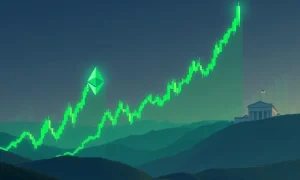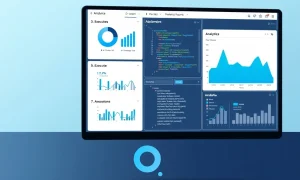The financial world is buzzing. A significant **stock market rally** has captivated investors. This surge follows recent remarks from Federal Reserve Chair Jerome Powell. Many market participants are now evaluating its true nature. Is this a robust, enduring upward trend? Or does it merely represent a ‘late-summer rally’ that could soon fade? Understanding these dynamics is crucial for anyone navigating today’s complex economic landscape. This article will explore the factors behind the current market movements. It will also examine expert perspectives on its potential longevity.
Understanding the Recent Stock Market Rally Post-Powell’s Speech
Investors watched closely as Federal Reserve Chair Jerome Powell delivered his much-anticipated speech. His comments often provide critical insights into the Fed’s monetary policy. Following his address, the **stock market rally** gained considerable momentum. This immediate market reaction indicates how sensitive investors are to central bank communication. Powell’s remarks typically guide expectations for interest rates and economic growth. Therefore, any perceived shift can trigger significant trading activity.
Specifically, market participants interpreted certain aspects of Powell’s speech positively. They may have found reassurance regarding the pace of future interest rate hikes. Or perhaps they saw signs of a potential ‘soft landing’ for the economy. A ‘soft landing’ refers to controlling inflation without causing a recession. This perception often fuels optimism. Consequently, it encourages increased investment in equities. The immediate aftermath saw major indices like the S&P 500 and Nasdaq Composite register notable gains. This strong performance marked a continuation of the upward trend.
Many factors contribute to this market behavior. For instance, lower interest rate expectations can make borrowing cheaper for companies. This can boost corporate profits. Moreover, it makes future earnings more valuable in present terms. Conversely, higher rates can dampen economic activity. Thus, any hint of a less aggressive stance from the Fed can ignite a buying spree. This recent **stock market rally** is a clear example of such a response. However, observers remain cautious about its underlying strength.
What Defines a ‘Late-Summer Rally’?
The term ‘late-summer rally’ often describes a temporary surge in stock prices. This typically occurs during the quieter trading months of August and September. Such rallies are often characterized by lower trading volumes. They can also be driven by specific, short-term catalysts. Importantly, they may lack broad-based fundamental support. These rallies can offer quick gains. However, they often reverse course as the year progresses. Therefore, distinguishing a genuine bull market from a transient upswing is vital for investors.
Historically, market patterns sometimes show seasonal variations. Summer months can see reduced institutional trading. Many fund managers and analysts take vacations. This can lead to lower liquidity. In turn, smaller trading volumes can amplify price movements. A relatively minor positive news item can then trigger a disproportionately large **stock market rally**. This scenario is common during these periods. However, these gains may not reflect underlying economic strength. Instead, they might be more indicative of market mechanics.
Key characteristics of a potential ‘late-summer rally’ include:
- **Limited Participation:** Gains are concentrated in a few sectors or large-cap stocks.
- **Low Volume:** Trading activity is notably lighter than usual.
- **Lack of Fundamental Drivers:** The rally is not strongly supported by improving economic data or corporate earnings.
- **Short Duration:** The upward trend typically lasts for weeks rather than months.
Recognizing these signs helps investors assess the sustainability of current market movements. Furthermore, it informs their risk management strategies. A deeper analysis reveals if the rally has the legs to continue or if it is merely a seasonal blip.
Driving Forces Behind the Current Stock Market Rally
Several factors have converged to fuel the recent **stock market rally**. Beyond Powell’s speech, economic data and corporate performance play significant roles. Investors constantly evaluate these indicators. Positive surprises can bolster confidence. Conversely, negative news can quickly erode gains. Therefore, a multifaceted approach is necessary to understand the market’s upward trajectory.
One primary driver is the improving sentiment around inflation. Recent reports have shown a moderation in price increases. This suggests that the Federal Reserve’s aggressive rate hikes might be working. Lower inflation reduces the pressure for further tightening. Consequently, it creates a more favorable environment for equities. Companies can better manage costs. Consumers may also feel more confident about their purchasing power. This positive outlook often translates into higher stock valuations.
Moreover, corporate earnings reports have generally exceeded expectations. Many companies have demonstrated resilience. They have managed to maintain profitability despite economic headwinds. Strong earnings provide a fundamental basis for stock price appreciation. They indicate healthy business operations. This performance reassures investors. It suggests that companies can navigate current challenges effectively. Therefore, robust earnings seasons often contribute significantly to a sustained **stock market rally**.
Other contributing factors include:
- **Falling Energy Prices:** Lower oil and gas prices reduce operational costs for businesses and increase disposable income for consumers.
- **Technological Advancements:** Innovation in specific sectors, especially technology, continues to drive growth and investment interest.
- **Retail Investor Engagement:** Increased participation from individual investors can provide additional buying pressure.
These elements collectively paint a picture of cautious optimism. However, the interplay of these forces remains dynamic. Market participants must continuously monitor them.
Potential Headwinds and Risks to the Rally’s Longevity
Despite the current optimism, significant risks could challenge the sustainability of this **stock market rally**. Investors must consider these potential headwinds. They can quickly reverse positive trends. Economic forecasts are inherently uncertain. Therefore, a balanced perspective is essential. Understanding the downside risks helps in making informed investment decisions.
Inflation remains a persistent concern. While it has shown signs of moderating, it is not yet fully under control. A resurgence in inflation could force the Federal Reserve to resume aggressive rate hikes. This would undoubtedly dampen market enthusiasm. Higher interest rates increase borrowing costs for businesses and consumers. This can slow economic growth. Furthermore, it makes bonds more attractive relative to stocks. This shift in investor preference could lead to capital outflows from equities.
Geopolitical tensions also present a significant risk. Ongoing conflicts and trade disputes can disrupt supply chains. They can also create uncertainty in global markets. Such events often lead to increased volatility. They can trigger sudden market downturns. Therefore, geopolitical stability is crucial for a sustained **stock market rally**. Any escalation could quickly undermine investor confidence. This would consequently lead to a sell-off.
Other potential risks include:
- **Economic Slowdown:** A deeper-than-expected economic recession would hurt corporate earnings and consumer spending.
- **Corporate Debt Levels:** High levels of corporate debt could become problematic if interest rates rise further or economic conditions worsen.
- **Market Overvaluation:** Some analysts suggest that current stock prices may not fully reflect underlying fundamentals, indicating potential overvaluation.
These challenges highlight the need for vigilance. They remind investors that market rallies are rarely linear. Careful monitoring of these risks is paramount for navigating the coming months.
Expert Opinions on the Current Stock Market Rally
Market analysts and economists hold diverse views on the current **stock market rally**. Some believe it represents a genuine turning point. They cite improving economic data and resilient corporate earnings. Others remain more cautious. They suggest it might be a temporary phenomenon. These differing perspectives offer valuable insights for investors. They underscore the complexity of predicting market movements. Therefore, examining a range of expert opinions provides a more comprehensive understanding.
Optimistic experts often point to the strength of the labor market. They highlight robust consumer spending. These factors suggest underlying economic resilience. They argue that inflation is indeed cooling. This allows the Fed to potentially pause its tightening cycle. A more predictable interest rate environment typically supports higher equity valuations. Moreover, technological innovation continues to drive growth in key sectors. This provides a strong foundation for continued market gains. They see the current **stock market rally** as a sustainable recovery.
Conversely, more skeptical analysts warn of potential pitfalls. They emphasize that the economy still faces significant challenges. They point to elevated interest rates. They also highlight the lagged effects of monetary policy. These effects may not have fully materialized yet. Some suggest that current valuations are stretched. They believe the market has priced in an overly optimistic scenario. Furthermore, they stress the possibility of a ‘late-summer rally’ effect. This means the gains could be fleeting. They advise caution and a focus on defensive assets.
For example, a prominent investment bank might suggest:
- **Scenario 1 (Optimistic):** Inflation continues to cool, Fed pivots to rate cuts, leading to a sustained bull market.
- **Scenario 2 (Cautious):** Inflation remains sticky, Fed maintains higher rates, causing market consolidation or a correction.
- **Scenario 3 (Bearish):** Unexpected economic shock triggers a recession, leading to a significant market downturn.
Ultimately, investors must weigh these varied expert opinions. They need to align their strategies with their own risk tolerance. The consensus remains elusive. This highlights the importance of independent research and careful consideration.
Investment Implications and Strategies During a Stock Market Rally
Navigating a **stock market rally**, especially one with ‘late-summer rally’ characteristics, requires careful consideration. Investors need to assess their portfolios. They must also adjust their strategies. This period can offer opportunities. However, it also carries risks. Therefore, a disciplined approach is essential for long-term success. Understanding the potential scenarios helps in making informed decisions.
For those optimistic about the rally’s sustainability, increasing exposure to growth-oriented sectors might be appealing. Technology and consumer discretionary stocks often perform well in rising markets. However, diversification remains crucial. Spreading investments across various asset classes and sectors can mitigate risk. Furthermore, focusing on companies with strong fundamentals is always a prudent strategy. These companies tend to weather market fluctuations better.
Conversely, investors wary of a ‘late-summer rally’ might adopt a more defensive stance. This could involve increasing allocations to value stocks. It might also mean investing in sectors less sensitive to economic cycles, such as utilities or healthcare. Holding a higher cash position provides flexibility. It allows investors to capitalize on potential future dips. Additionally, considering hedging strategies can protect against downside risk. This approach emphasizes capital preservation over aggressive growth.
Key strategies to consider:
- **Rebalance Portfolios:** Ensure asset allocation aligns with current risk tolerance and market outlook.
- **Review Fundamentals:** Invest in companies with strong balance sheets, consistent earnings, and competitive advantages.
- **Stay Diversified:** Avoid overconcentration in any single stock or sector.
- **Consider Dollar-Cost Averaging:** Invest a fixed amount regularly, reducing the impact of market volatility.
- **Monitor Economic Indicators:** Keep an eye on inflation, interest rates, and employment data for early signs of shifts.
Ultimately, individual investment goals and risk tolerance should guide decisions. Consult with a financial advisor. This can help tailor strategies to personal circumstances. The current **stock market rally** presents both opportunities and challenges. Thoughtful planning is key.
Conclusion: Assessing the Stock Market Rally’s True Nature
The recent **stock market rally** has generated considerable excitement. It follows Fed Chair Powell’s speech and generally positive economic data. However, a critical question remains: Is this a lasting surge, or is it merely a ‘late-summer rally’? The answer likely lies in a nuanced interpretation of ongoing economic trends. While current momentum is strong, underlying risks persist. These include persistent inflation and geopolitical uncertainties. Investors must remain vigilant. They need to monitor key indicators closely. This will help them discern the rally’s true durability. A balanced approach, combining optimism with caution, is essential. This ensures prudent decision-making in these dynamic market conditions.
Frequently Asked Questions (FAQs)
Q1: What is a ‘late-summer rally’ in the stock market?
A ‘late-summer rally’ refers to a temporary increase in stock prices. It typically occurs during the summer months, particularly August and September. These rallies often have lower trading volumes. They may also lack strong fundamental support. They can reverse course as the year progresses.
Q2: How did Fed Chair Powell’s speech impact the stock market rally?
Fed Chair Powell’s speech often provides clues about future monetary policy. Investors interpreted his recent remarks positively. This led to increased optimism about interest rates and economic stability. Consequently, this perception fueled a significant upward movement in the stock market.
Q3: What factors are currently driving the stock market rally?
Several factors are contributing to the current rally. These include moderating inflation reports and resilient corporate earnings. Lower energy prices and continued technological advancements also play a role. Positive investor sentiment further supports the upward trend.
Q4: What are the main risks to the sustainability of this stock market rally?
Key risks include a resurgence of inflation, which could lead to further interest rate hikes. Geopolitical tensions also pose a threat. Additionally, a deeper economic slowdown or concerns about market overvaluation could challenge the rally’s longevity.
Q5: How should investors approach the market during this rally?
Investors should consider their risk tolerance and investment goals. Diversification across sectors and asset classes is crucial. Reviewing company fundamentals and monitoring economic indicators are also important. Some may rebalance portfolios towards growth, while others might adopt a more defensive stance.






















